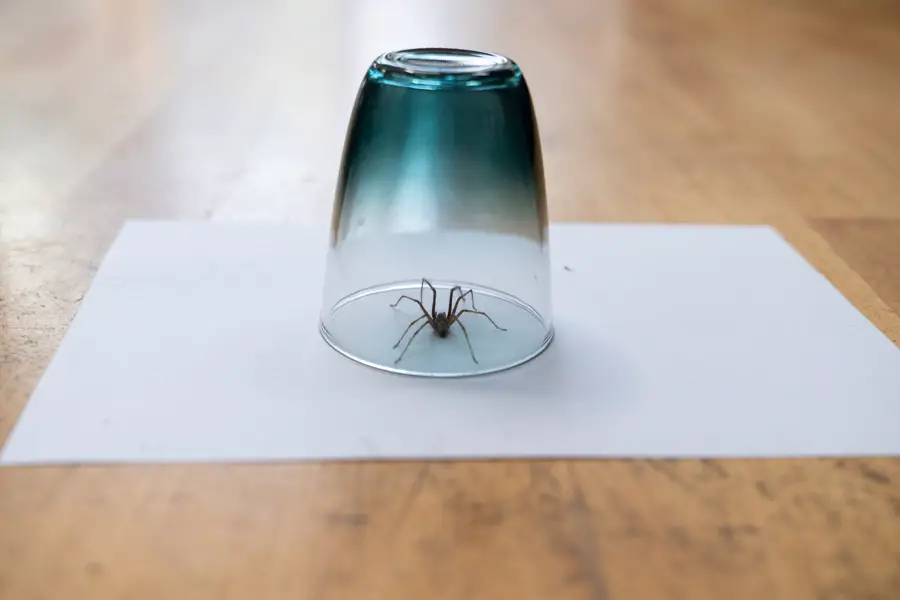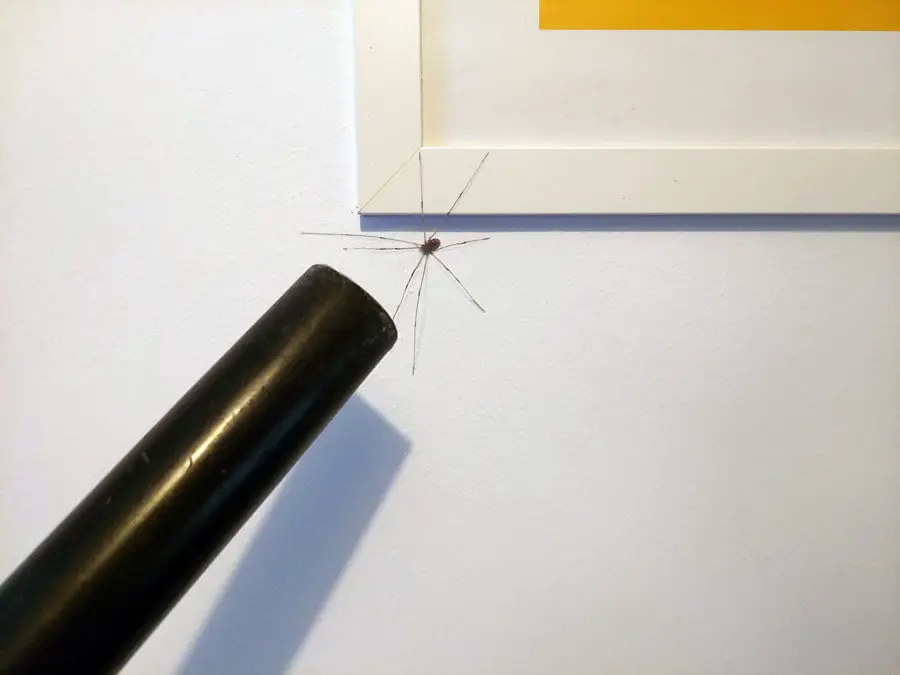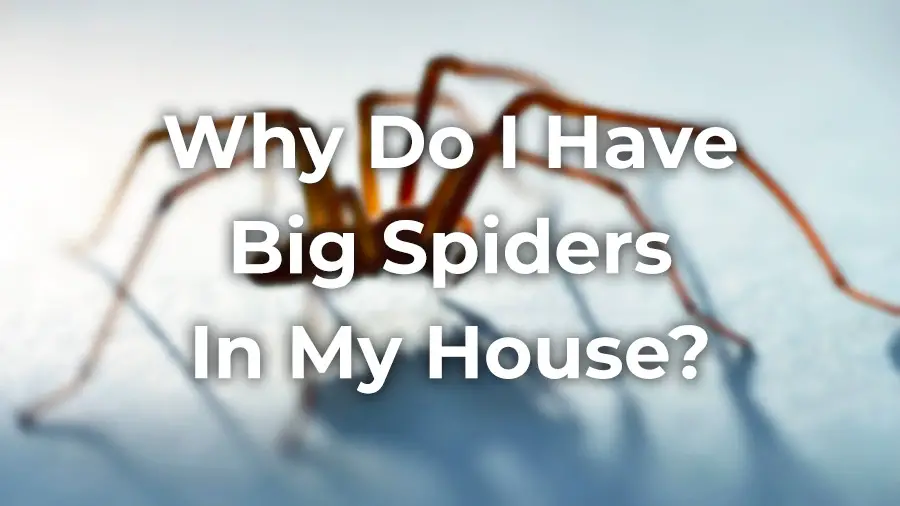The presence of big spiders in a house is not at all unusual. For some people they may be annoying or even intimidating, however, they are in their homes for a reason.
Although the vast majority of spiders are harmless, there are a few species that can be dangerous, therefore should be avoided (the number of these species depends mainly on the climate where you live).
In this article, we’ll explore the possible reasons why you have big spiders in your house, how they get inside, and how you can identify them. Furthermore, I’ll also show you several methods to get rid of them.
Reasons Why You Have Big Spiders In Your House
First of all, spider species can be divided into two main groups. Those that have evolved to live and reproduce mainly indoors and those that are completely adapted to outdoor conditions.
Depending on which group the spiders in your home belong to, you need to apply slightly different strategies to get rid of them or to keep them outside the house.
Most big spiders usually live in natural habitats and only occasionally appear indoors.
Spiders That Are Adapted to Indoor Life
Some species spend their whole life indoors. They are born and live there and rarely or never leave the house, the garage, or the storage shed.
As these spiders are usually not well adapted to the outdoor environment, if for some reason they get outside and can’t find a man-made habitat, they may not survive for long. It’s especially true when the difference between the temperature outside and inside is significant.
So, in most cases, these spiders are not coming from outside. Likely, a few of them have always lived in your house, but now their numbers have increased due to favorable conditions (more on those later).
Some common species that usually live indoors:
- American house spider (common house spider)

- Giant house spider

- Daddy longlegs (aka cellar spider)

Giant house spiders are one of the biggest spiders you can find in your home. These brown arachnids can have a leg span of up to 4 inches, so they are quite huge sometimes. Fortunately, they don’t really pose a threat to most humans.
Spiders That Are Adapted to Outdoor Life
While this group of spiders can be found mainly outdoors, sometimes they do appear in homes as well.
This can happen by chance or because of harsh outdoor conditions. In the latter case, spiders move into a man-made habitat (such as your house) to find food and shelter.
However, as soon as the outdoor conditions become favorable again, they usually leave the house (if they can).
Outdoor adapted spiders usually have a larger body than indoor adapted species.
Some common species that typically live outdoors:
- Hobo spider
- Orb-weaver spiders
- Yellow sac spiders
- Jumping spiders
- Black widow
- Brown recluse
- Grass spiders
- Wolf spider
How to Identify Spiders
In most cases, you can easily identify a spider based on its appearance. However, the most important thing is to know if you’re dealing with a venomous spider that can be a threat to humans.
Fortunately, there are only two really dangerous spider species in the US. Black widow and brown recluse spider bites can be life-threatening.
They usually can be found outside buildings, however, sometimes they can appear indoors as well.
Female black widows have a reddish hourglass marking on their abdomen. The shape and appearance of this marking vary among the different widow spiders. Female black widows can grow as big as 0.5 inches long without legs (up to 1.5 inches with legs).
The main characteristic of the brown recluse spider is the violin-shaped marking on its body. It’s about 1 inch long including legs (the body is usually less than 0.5 inches long), so it’s really not a huge spider.
Here’s what they look like:

Spiders typically don’t attack humans for no reason. Most bites happen when someone comes into direct contact with either the spider or the web.
The larger the spider, the more likely that it can bite through your skin, however, unless it’s a venomous species, there’s usually no cause for concern (unless you’re allergic to spider bites).
FYI – If you’re also having tiny spiders in your house, make sure you check out this article in which I explain everything you need to know about the causes and solutions in detail.
How Do Big Spiders Get Into Your Home?
As we’ve already discussed, there are two main groups of spiders: those that live primarily outside the house, and those that live indoors.
Large spiders living outside can appear in your home for two reasons:
- they get in the house by accident
- the conditions inside your home are more favorable (to survive or lay eggs)
How do they get inside?
Big spiders usually enter a house through open windows or doors. Occasionally they wander into a building through larger cracks, holes, or air vents.
Sometimes larger spiders get inside unintentionally with objects that a human carries from outside into the house. Spiders often travel on plants, and tools, inside boxes, or among firewood.
Indoor living house spiders usually stay inside for a lifetime. If their number keeps increasing, chances are good that a female previously placed an egg sac somewhere in your home and the eggs have hatched.
As time goes by, the newborn spiders become larger and larger. Most spiders reach adulthood in just a few weeks or months.
What Attracts Large Spiders?
Although most species can live several weeks without food and water, spiders need food and shelter to survive.
While for a tiny spider it may be enough to eat a few mosquitos, drain flies, or ants once a week, a big spider needs much more food.
Therefore large spiders usually settle in a place where there are plenty of insects.
Spiders also need water, so they prefer wet sites. Dark, moist, and cluttered areas are ideal shelters for most arachnids.
If your home continuously provides favorable conditions, there’s a good chance that spiders will appear and multiply.
In the presence of abundant food and the absence of natural predators, the spider population sometimes can grow rapidly. However, spiders usually do not tolerate close proximity to each other, so that’s a limiting factor.
Keeping your home clean and tidy will in itself significantly reduce the number of spiders in your home.
How To Get Rid Of Them?
The first question is whether you should get rid of spiders or not.
While some people may consider spiders to be pests, they can be pretty useful creatures.
Spiders are natural predators of insects and bugs, therefore they control the number of all kinds of pests in your house, including annoying flies and mosquitos that may carry diseases.
So, if you have a few harmless spiders in your house, even if they seem to be pretty large, ignoring them can be a reasonable strategy.
Instead of completely exterminating all spiders, a more useful approach may be to control their number. Still, want to get rid of all of them? Then just read on.
If you’re dealing with a large infestation that you think you can no longer handle, calling a pest control service can put an end to the spider problem.
How to Find Them
If you need to find all (or most) spiders in your home, you should look for telltale signs, such as webs or spider eggs.
Common places where large spiders hide in a house:
- crawl spaces
- attic
- basement
- under plant leaves
- in a dark corner of a room
- under the sink
- inside storage units
- under beds
- behind furniture
- under stairs
How to Catch Them
If you want to catch a big spider alive, first try to identify the species and make sure it’s harmless.
As we’ve already discussed, in the US (and in the UK) most spiders are not venomous. However, to be on the safe side, make sure you wear a pair of thick gardening gloves and long sleeves.
Spiders can be very fast and once they feel threatened, they immediately hide in small cracks where you often can’t reach them.
While using a jar or a mug is a popular way of catching spiders alive, you need to be clever and fast if you choose this method. As an alternative, you can sweep the spider up using a dustpan.

A simpler approach is to use a critter catcher. This will let you keep a safe distance between you and the spider.
Another way of getting rid of big spiders is to use your vacuum cleaner and then get rid of the entire vacuum bag (do not throw it in a trash can that you keep inside).

If it’s not important to catch the spiders alive, you can use a pest control spray or a spider trap.
If you need to lure a spider out of its hiding spot, you can do that by throwing a small insect, such as a fly, into the web. As an alternative, you can gently vibrate the web.
How to Prevent Spiders From Coming Back?
If you want to stop spiders from coming back to your house, you need to set up an unfriendly environment for them.
It’s important to understand that it takes a lot of effort to permanently keep each and every spider out of your home and usually it doesn’t make much sense. Therefore your goal should be to keep their number to a minimum.
So, how can you do that?
Declutter the basement, the attic, crawl spaces, and every room in your house. Seal up large cracks, gaps, and holes and install insect screens. This will prevent outdoor living spiders from wandering into your home.
Spiders prefer undisturbed areas, so vacuum regularly, and once you spot a web or an egg sac, remove it immediately.
Double-check everything that’s brought inside from the yard and make sure it’s free of spiders.
Finally, use a natural spider-repellent spray to prevent spiders from returning.
Are These Big Spiders Dangerous?
When large spiders appear in a house, it can be a frightening experience for some people. In such a case, should you be concerned?
The two most dangerous spiders in the US are the black widow and brown recluse. These species are relatively small, their bodies are usually no more than 0.6 inches long.
That doesn’t mean big spiders won’t cause you any injury if you’re trying to catch them with your bare hands. However, if you take some simple precautions, such as wearing gloves, you don’t really need to be scared of non-venomous spiders.
When in doubt, don’t hesitate to ask for professional help.
Putting It All Together
As you can see, finding big spiders in a house is not uncommon by any means. If you’re living in the US, probably, what you’re facing is not a venomous spider. That’s because the most hazardous spiders here are not too large.
Some spiders are coming from the outside through windows, cracks, and gaps, while others have always lived indoors.
Spiders are attracted to places where they can hide and where food is abundant. They often build their web in undisturbed areas where they can hunt their prey quietly.
If you want to keep spiders outside your home, you have to create an unfavorable environment for them. You need to deprive them of food and shelter, to be precise.
Arachnids are handy creatures as they limit the insect population in your home. Therefore, in most cases, the best strategy is to keep the number of spiders under control (instead of completely exterminating them).
Photos: Wikimedia (Judy Gallagher, Ryan Hodnett, Shenrich91), Flickr (Conall, Lisa Zins)











